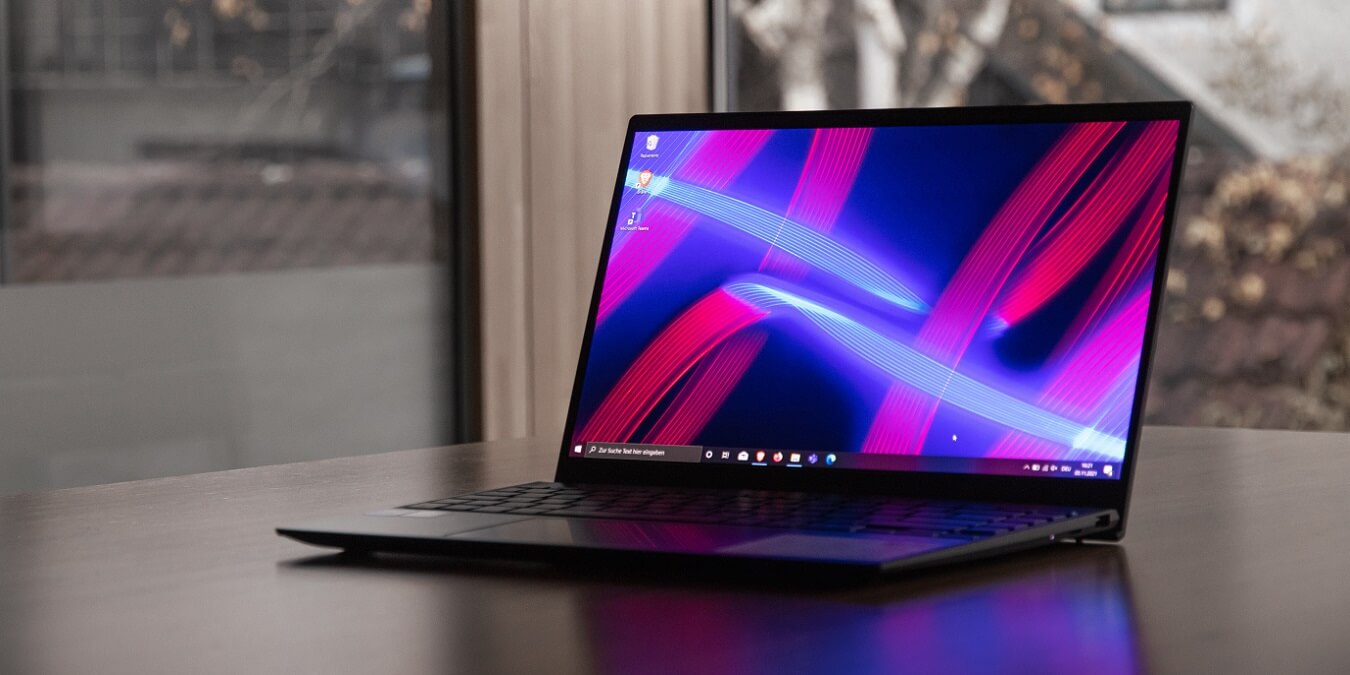
Don’t you hate it when you get a shiny new computer, and you find it to be full of programs you don’t want or need (or what we call bloatware)? The manufacturer added these programs to your computer to promote their apps or the apps of their partners. They waste space on your hard drive, appear on your Start menu, and sometimes they can run in the background and slow down your PC. Here we’ve put together a list of different ways to get rid of bloatware and unwanted applications.
Content
- 1. Uninstall Start Menu Programs
- 2. Traditional Uninstall
- 3. Uninstall Bloat From Control Panel
- 4. Remove Suggestions and Ads
- 5. Remove Bloatware with PowerShell
- 6. Third-Party Applications to Remove Windows Bloatware
- Frequently Asked Questions
Good to know: speed up your PC by learning how to stop background apps and processes from running in Windows.
1. Uninstall Start Menu Programs
This should be your first port of call in dealing with any Windows bloatware. The Start menu accumulates plenty of redundant apps that you may not be using. They tend to mysteriously show up after a major update, or a PC reset, and sometimes after you’ve installed other apps.
- In the following example, there are a few Windows applications that aren’t being used on this device such as TikTok, WhatsApp, ESPN, Instagram, and Facebook Messenger. Just right-click to uninstall these apps.
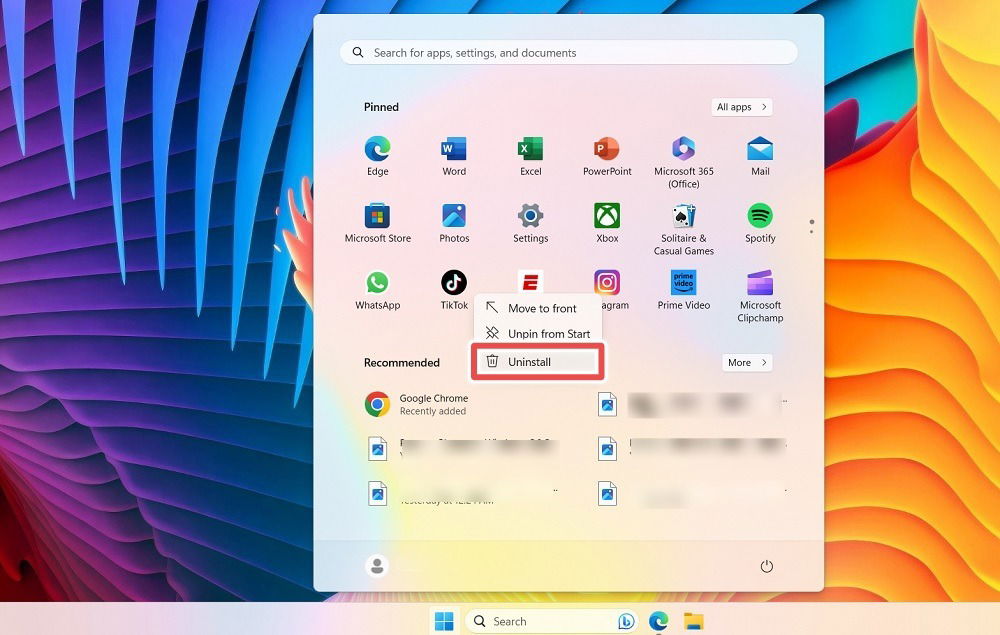
- After you’re done with the Windows pinned apps, click the “All Apps” button on the top right which will lead to a vertical list of all apps on your device.
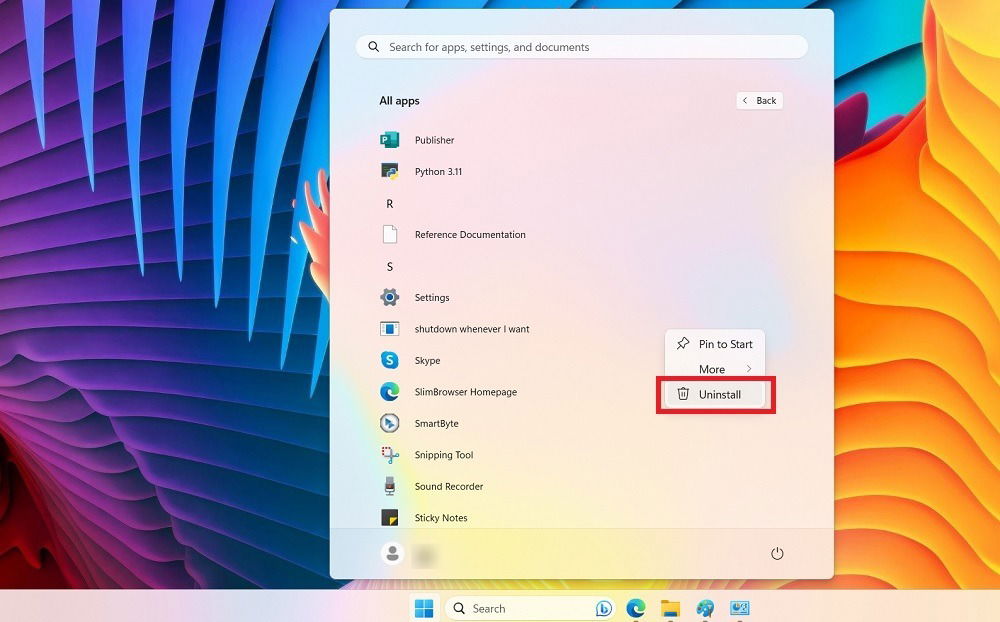
- You can identify the bloatware programs and right-click to uninstall them.
- In Windows 10, you can remove these programs from the right-hand side of the Start menu.
Tip: ensure your PC is not becoming too hot by knowing how to check your CPU temperature in Windows
2. Traditional Uninstall
You can remove some bloatware through the traditional “Uninstall” feature on Windows from the “Installed apps” on Settings.
- Open the Settings menu using Win + I.
- Go to “Apps -> Installed apps” in Windows 11, and “Apps -> Apps & Features” in Windows 10.
- Identify a bloat program, click the three dots next to it, and select “Uninstall.”
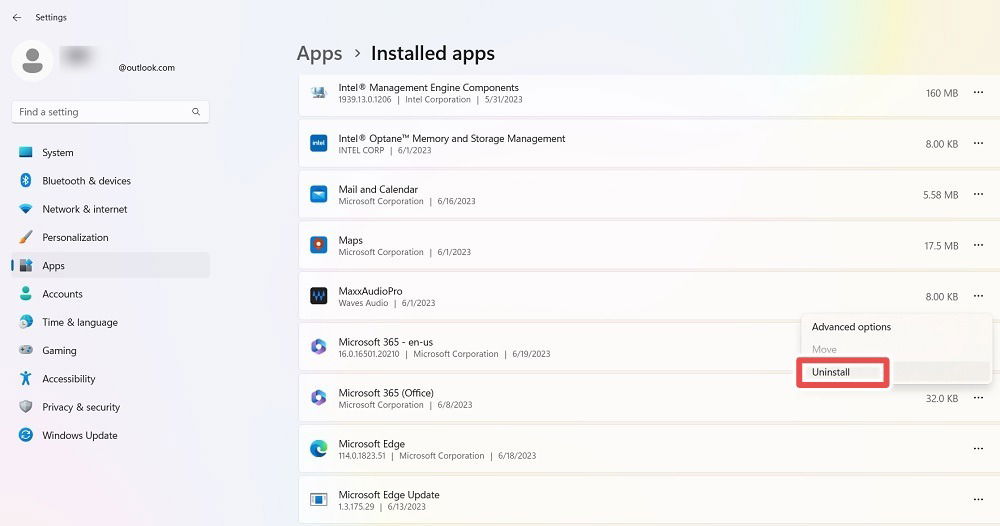
3. Uninstall Bloat From Control Panel
There are some stubborn programs such as your laptop maker’s built-in antiviruses that just won’t be removed from installed apps. The Control Panel offers a much more effective way to uninstall them.
- Open the Control Panel menu from Windows Search.
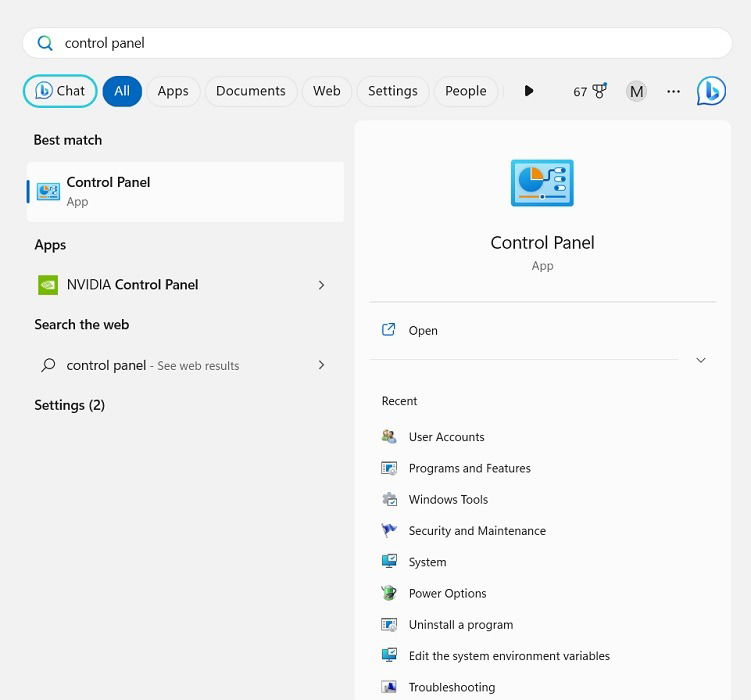
- Go to “Programs & Features.”
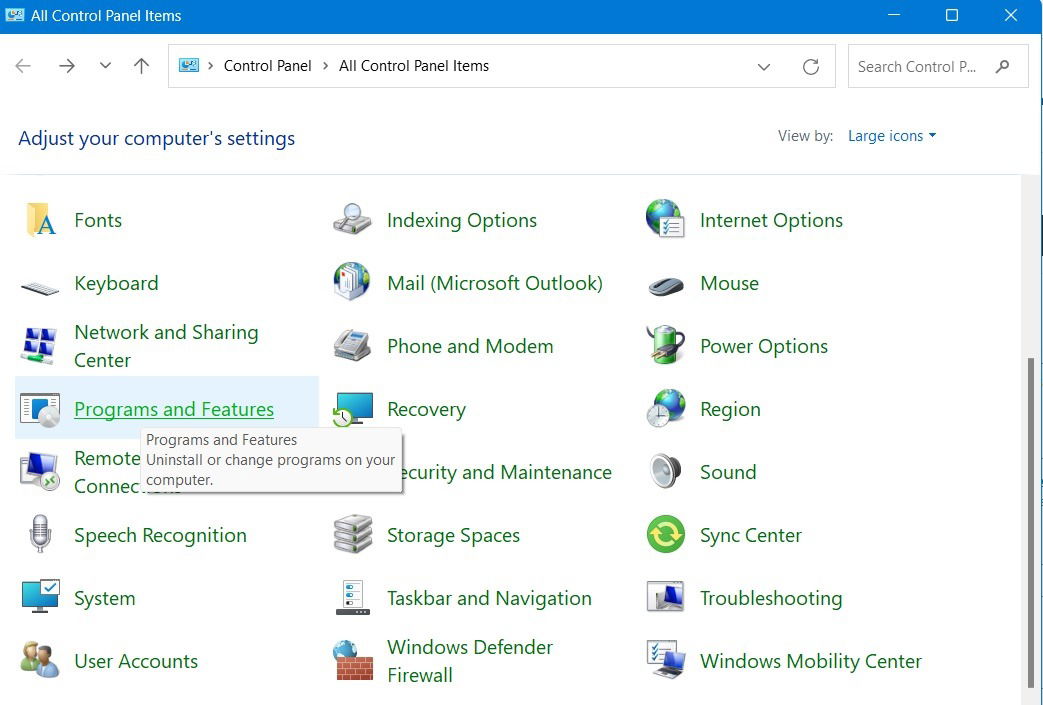
- Right-click on any bloatware app to uninstall it from the Control Panel window.
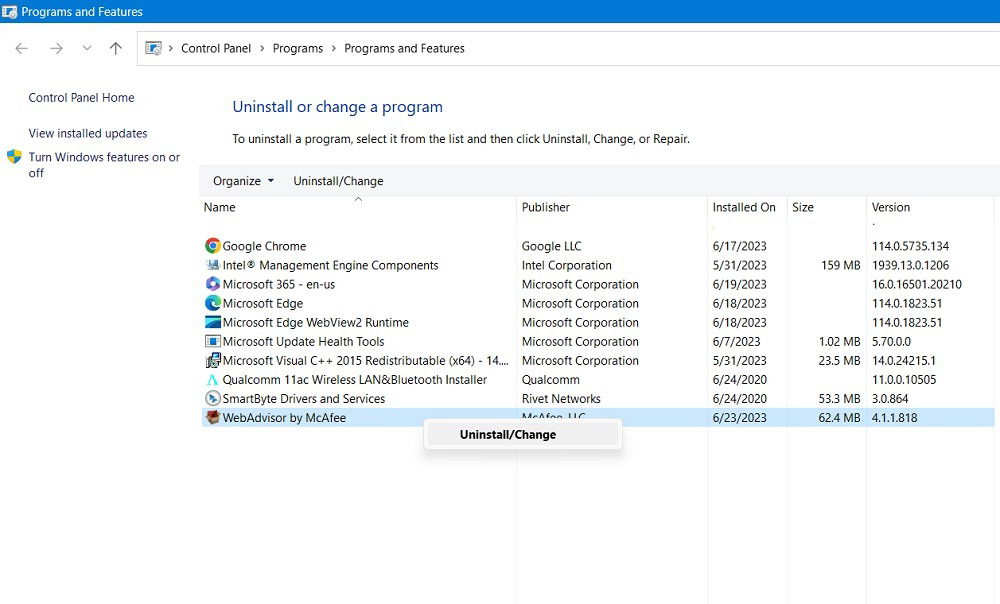
- Wait for the bloat to uninstall from your device. Then restart your PC.
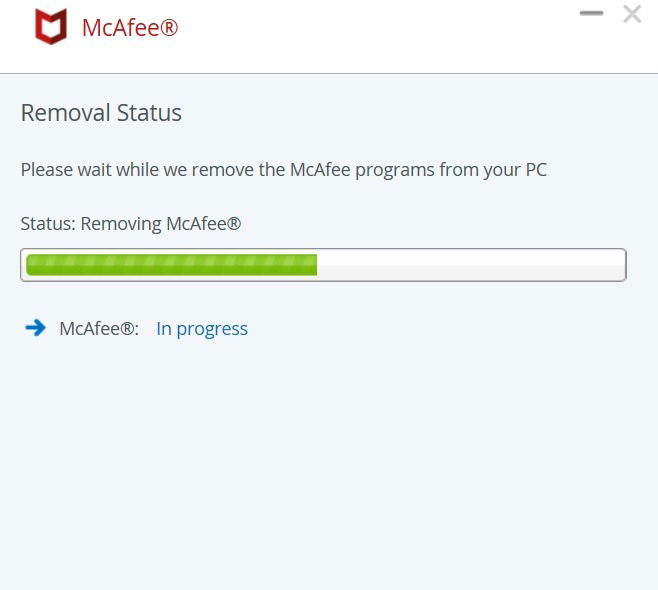
4. Remove Suggestions and Ads
More than any Windows version before them, Windows 10 and Windows 11 are intertwined with various companies and developers to promote certain products to you (or Microsoft’s own products that you probably don’t need). It’s annoying and takes away the feeling that this is your operating system. So how do you get rid of this particular brand of bloat?
- In Windows 11, check “Settings -> Privacy & security -> General”. Windows 10 users should go to “Settings -> Personalization -> Start.”
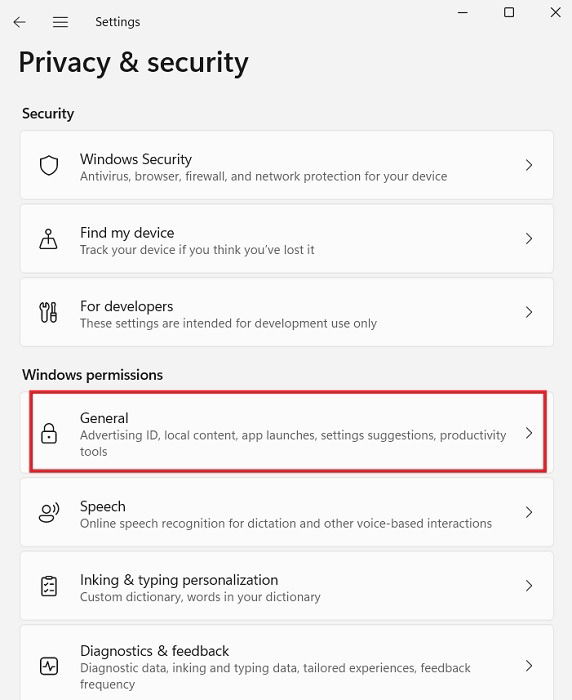
- Here you can pretty much switch all the On/Off sliders to the “Off” position to improve your privacy.
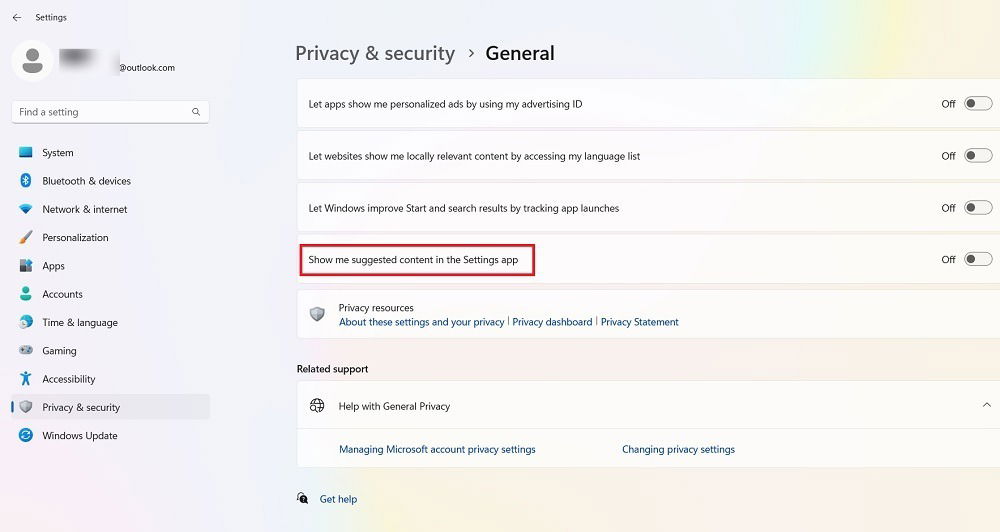
- The particular bloatware-specific option here is the one that says: “Show me suggested content in the Settings app” in Windows 11 which would be giving you pointers to apps and information that you almost certainly don’t want. Keep it turned off.
- In Windows 10, the bloatware is indicated by “Show suggestions occasionally in Start” which again should be turned off.
Good to know: get up to speed with these essential PowerShell commands you should be aware of.
5. Remove Bloatware with PowerShell
Windows PowerShell is a shell, or user interface, developed by Microsoft for task automation and configuration management. We can use PowerShell to remove bloatware in two different ways:
1. Hiding Apps Using “Remove-AppxPackage”
This first procedure hides the apps without actually deleting them from your system. This method is best if you don’t want the app reappearing in the event Windows reinstalls it after a system update.
Before you uninstall apps, make sure no other programs are running on your computer. Then start PowerShell in Administrator mode.
- Type “powershell” in the search box in the lower-left corner. Click “Run as Administrator.”
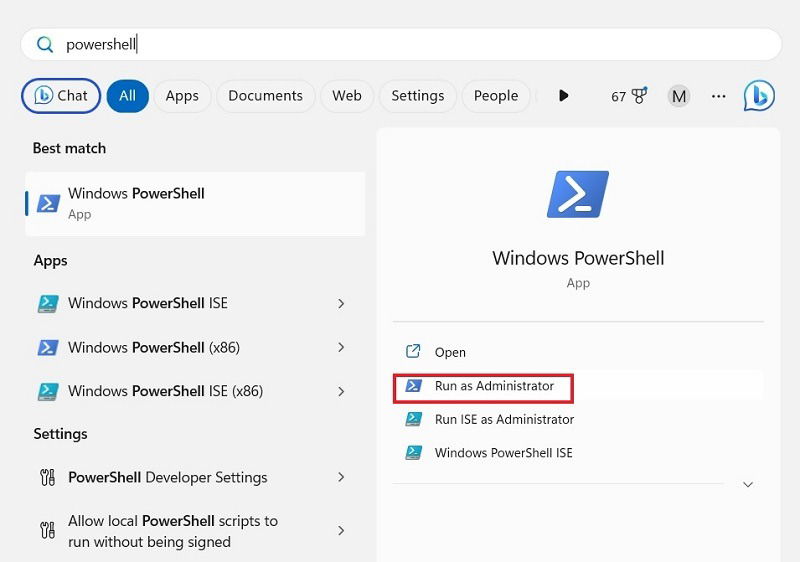
- Enter the command listed below for the program you want to uninstall. Replace “appName” with the actual name of the application you want to uninstall and press Enter.
Get-AppxPackage *appName* | Remove-AppxPackage
- Repeat for other programs you want to remove.
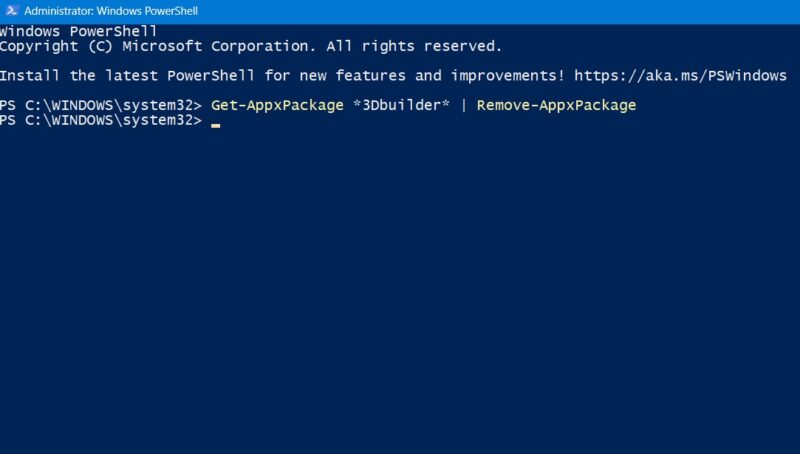
- You don’t have to recall a program’s exact name. To know what must be removed, enter the following command which gives a list of all installed apps on your Windows device.
get-AppxPackage
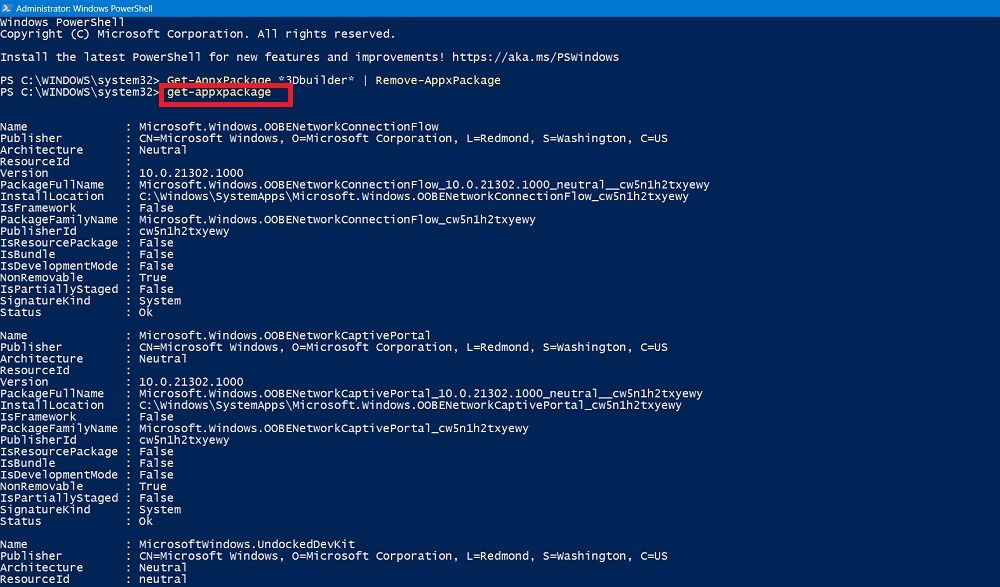
- Locate the program you wish to uninstall and then type the command using its name. In the following example, Skype is being removed from the list.
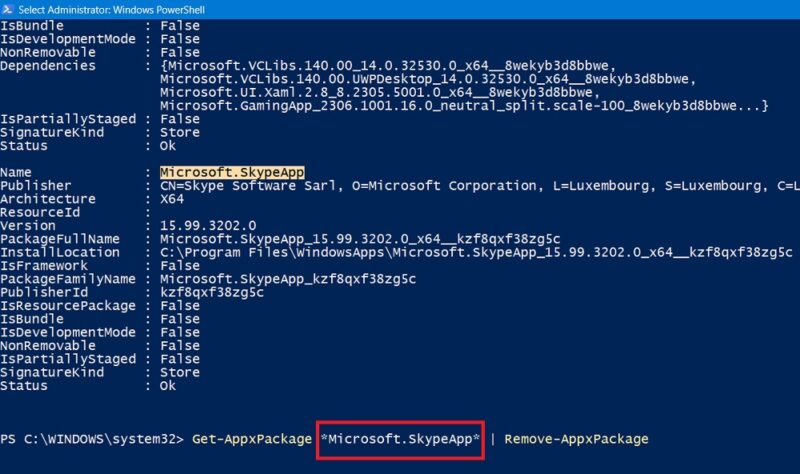
Tip: learn all about the most common Windows problems and discover ways how to fix them.
2. Delete Bloatware Using DISM
If you want to obliterate all bloatware from your system totally, you can use a different command in PowerShell called DISM (stands for Deployment Imaging Service and Management.)
- In your Powershell window (Admin mode,) view the entire list of system bloatware using the following command:
DISM /Online /Get-ProvisionedAppxPackages | select-string Packagename
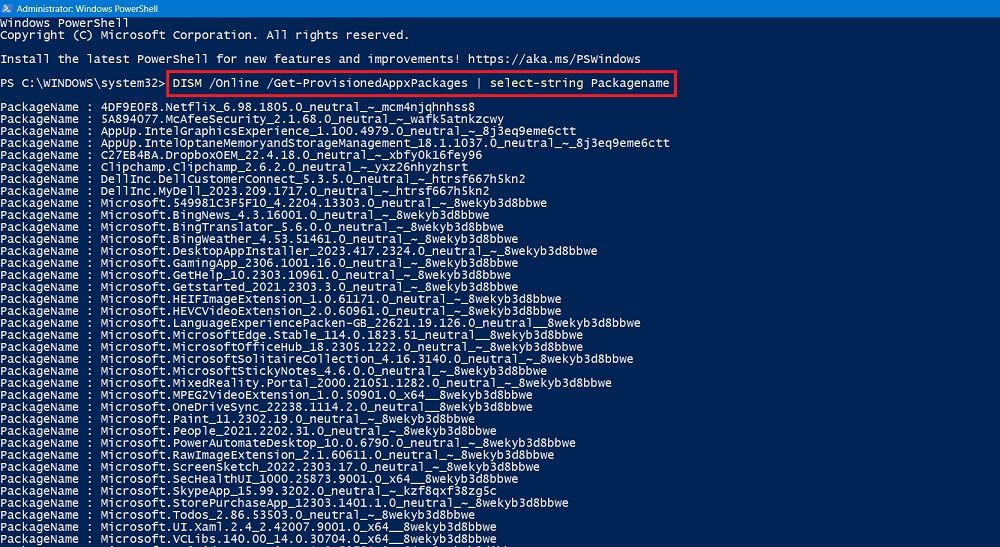
- Locate an app you want to delete from your system entirely.
- Copy the app’s package name. In this example, we have copied the entire line for Microsoft Solitaire Collection.
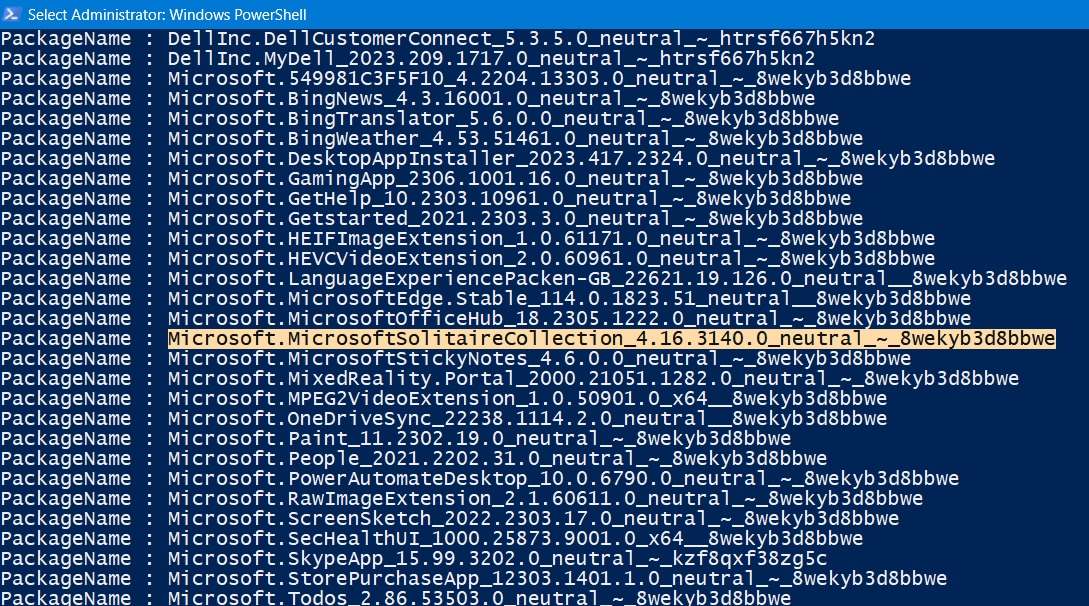
- Type the following command. It will remove Microsoft Solitaire Collection from the given device. Replace the Microsoft Solitaire Collection package name with any other package name for an app you wish to delete.
DISM /Online /Remove-ProvisionedAppxPackage /PackageName:"Microsoft.MicrosoftSolitaireCollection_4.16.3140.0_neutral_~_8wekyb3d8bbwe"
- The bloat program should be smoothly removed. You should see a message: “The operation completed successfully.”
- Restart your PC to finish any background processes related to the uninstall.
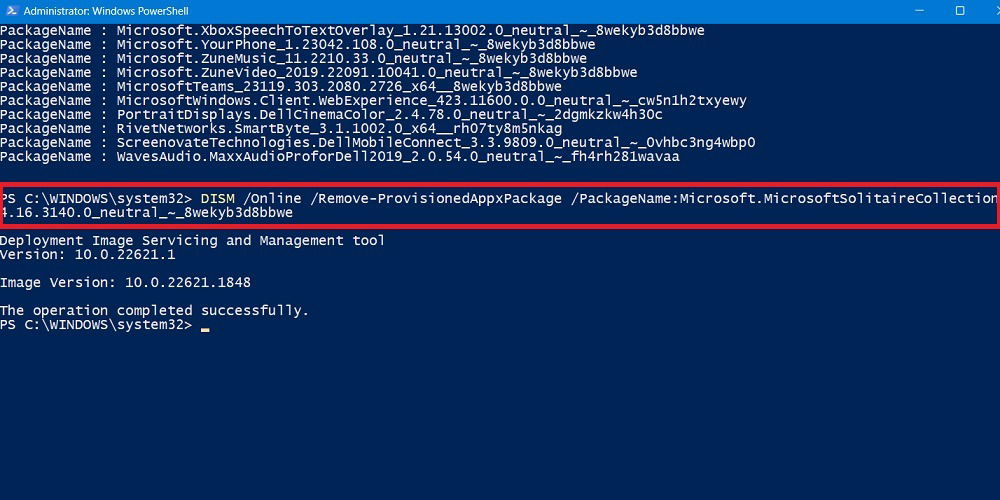
6. Third-Party Applications to Remove Windows Bloatware
Apart from regular Windows utilities, there are some third-party software applications that do a decent job of removing bloat. The examples featured below are compatible with all Windows versions up to the latest Windows 11, and we have tested them to be malware-free.
O&O ShutUp10++
O&O’s excellent tool for Windows can help you minimize the presence of bloatware on your device.
- The software can run directly from its executable file. No installation is needed.
- As soon as the app opens, you can view two sections: “Current User” and “Local Machine.” The former contains a list of settings for your PC that need to be toggled on.
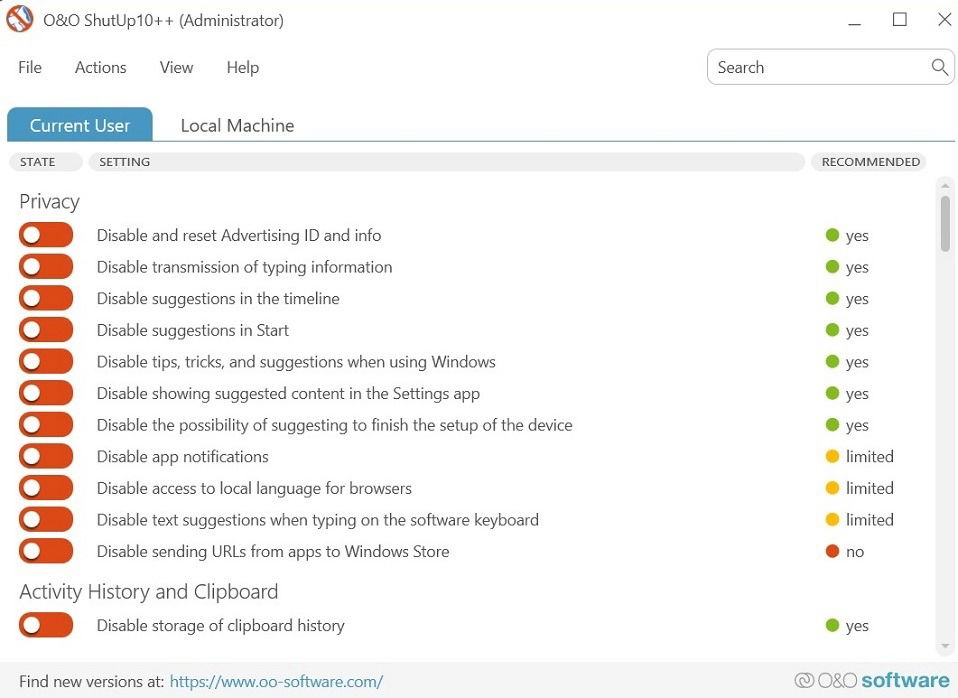
- You can choose to disable a huge number of privacy-compromising features in Windows that you may not have known about. Click the name of the feature to see a description of what it does and how it works. For instance, consider turning on options such as “Disable suggestions in Start” or “Disable tips, tricks, and suggestions when using Windows.”
- The O&O app will ask you to create a system restore point before letting you enable any feature. This is a good idea, as it will allow you to restore your system to a previous state if something goes wrong.
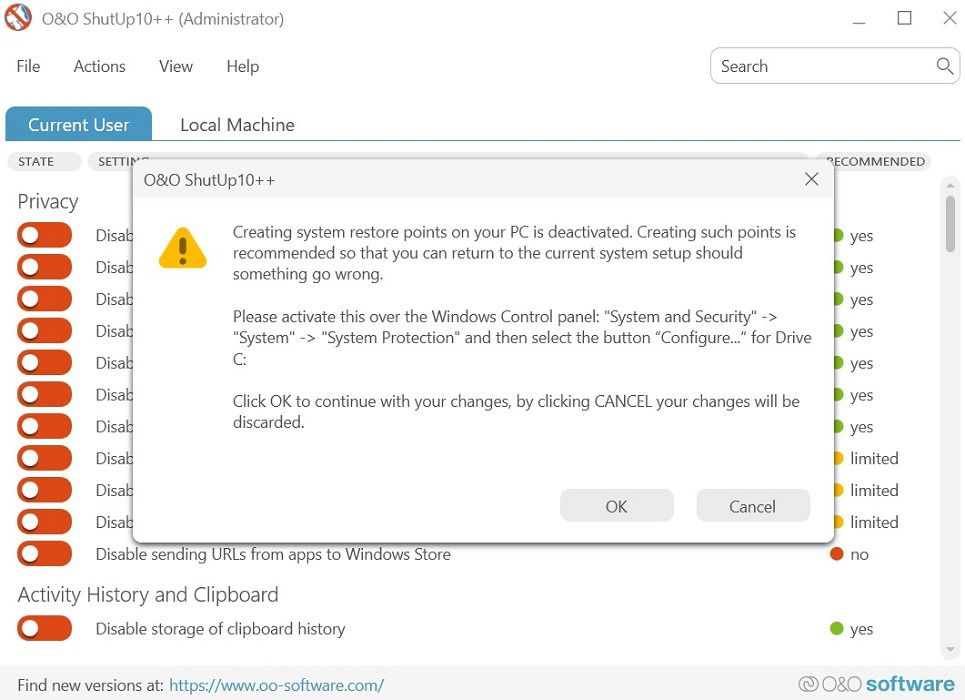
- If you’re unsure about what to toggle on, then just use the “Recommended” column on the right-hand side of ShutUp. Alternatively, you can select “Apply only recommended settings” from the “Action” tab.
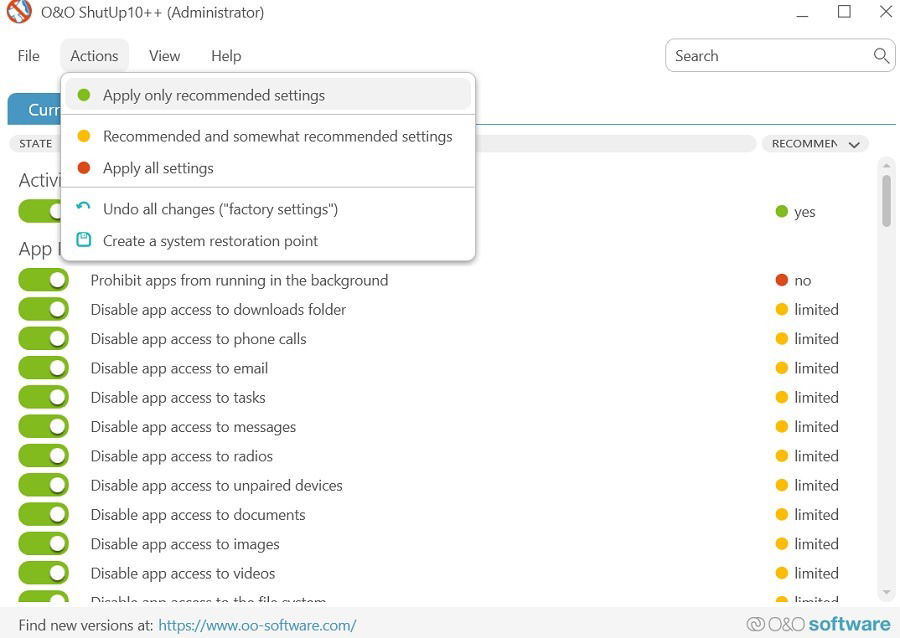
FYI: need to permanently remove a file on Windows? Here’s how you can securely delete files from your PC.
Windows10Debloater
If you are absolutely sure you want to delete all of the bloatware on your machine, you can use a third-party automated script called Windows10Debloater. It works with Powershell to remove all your bloat with one click of a button. Here is a list of the programs that will be removed. Although the name says, “Windows 10,” you can also use this app with Windows 11.
- Go to the official website and click the green “Code” button to bring up the “Download ZIP” button.
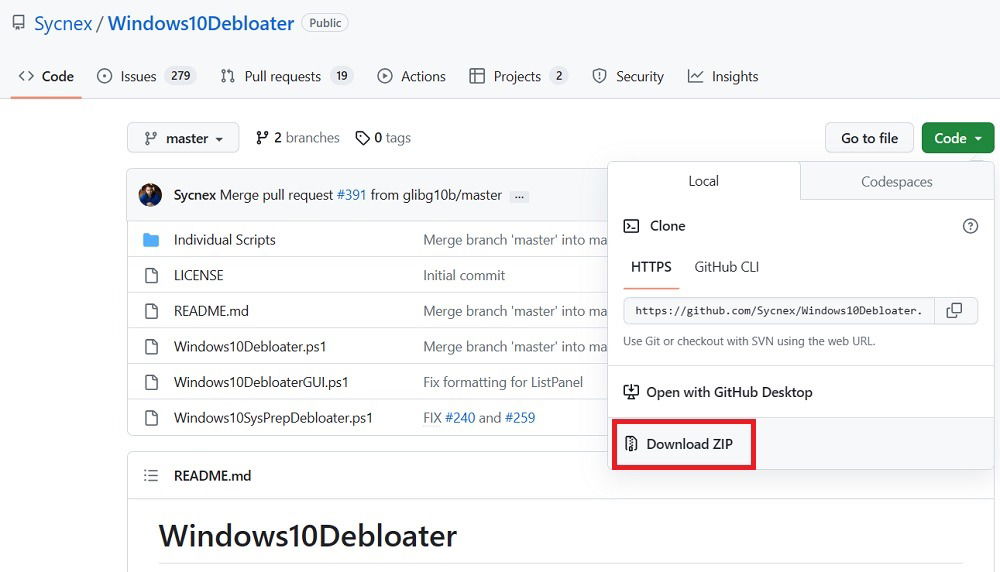
- Extract the .ZIP archive. Then right-click on Windows10DebloaterGUI and select “Run with PowerShell.”
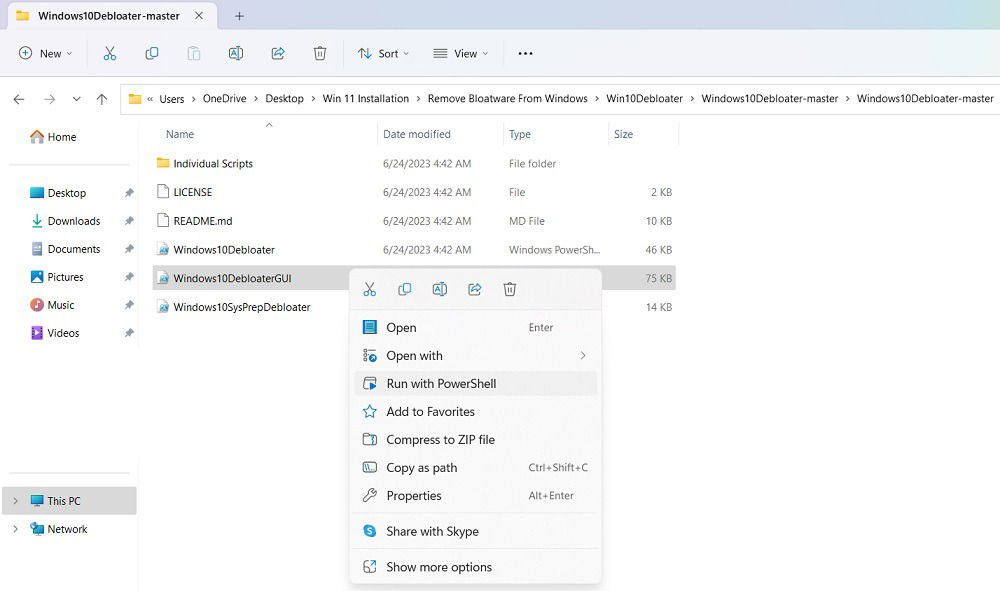
- A window for Windows10Debloater will open. Click the button, which says, “Remove All Bloatware.”
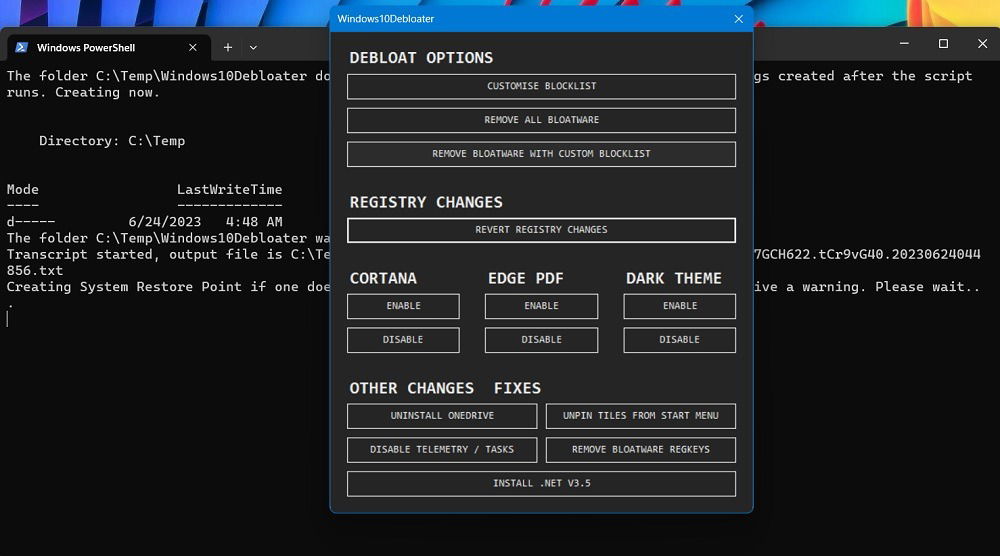
- The app will immediately begin uninstalling bloatware apps on your machine.
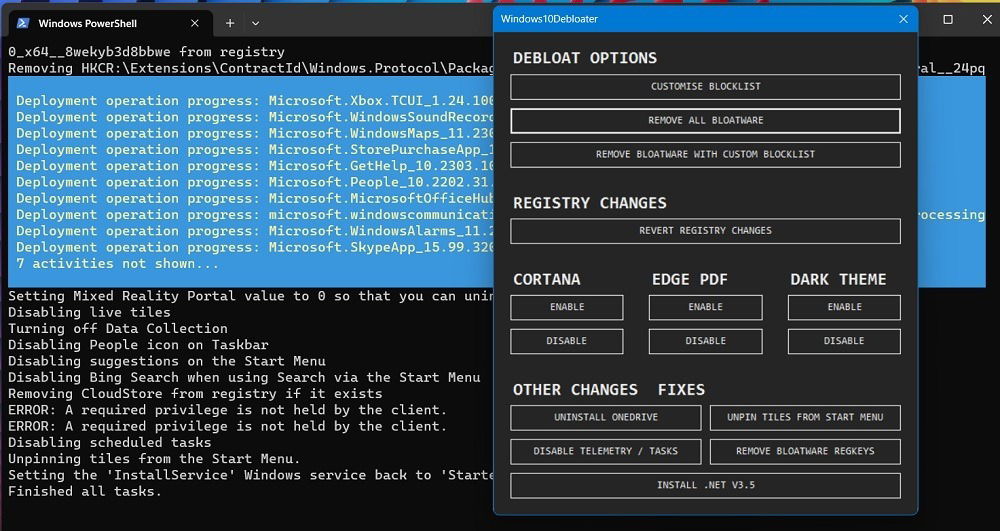
- As the bloat programs uninstall, you can see the success status of the apps that are being removed.
- In some cases, the Windows10Debloater app doesn’t have enough privileges to remove certain apps which leads to an error status.
Other recommended third-party applications that you can use to remove Windows bloatware are Bloatware Uninstaller and Revo Uninstaller.
Tip: getting the “Undoing changes on your computer” error on your computer? Check out our list of fixes that will help you resolve it quickly.
Frequently Asked Questions
Why am I seeing bloat after a Windows update?
Even though you can remove bloatware from Windows and free up space, you should be aware that major Windows updates tend to reinstall them right back on. Updates can consume quite a bit of storage space so your device might feel stuffed with more data, especially if you’re using an SSD with limited disk space (128~256 GB.)
To recover more storage space, you might also want to remove unwanted data from the “C” drive. Of course, there are ways to expand your PC’s storage without deleting anything, too.
Is it safe to remove bloatware from Windows?
As long as a bloat program is uninstalled easily, it is safe to remove it from your device. Even an essential application like Calculator or Snipping Tool can be conveniently removed. You can always reinstall these programs from Microsoft Store.
Image credit: Unsplash. All screenshots by Sayak Boral.

Sayak Boral –
Staff Writer
Sayak Boral is a technology writer with over eleven years of experience working in different industries including semiconductors, IoT, enterprise IT, telecommunications OSS/BSS, and network security. He has been writing for MakeTechEasier on a wide range of technical topics including Windows, Android, Internet, Hardware Guides, Browsers, Software Tools, and Product Reviews.
Subscribe to our newsletter!
Our latest tutorials delivered straight to your inbox
Sign up for all newsletters.
By signing up, you agree to our Privacy Policy and European users agree to the data transfer policy. We will not share your data and you can unsubscribe at any time. Subscribe